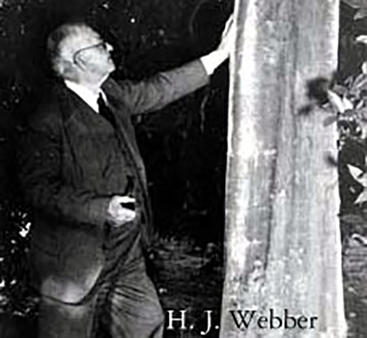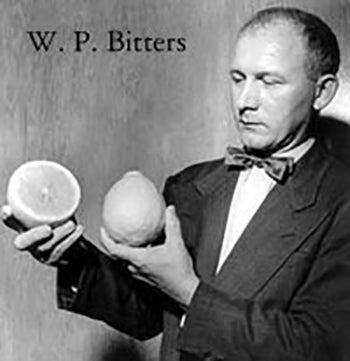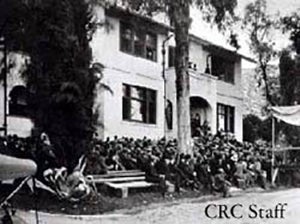California and most citrus-producing regions of the world have benefited from the existence of the UC Riverside Citrus Variety Collection. From the birthplace of citrus in China and India to the newest reaches of citrus ventures in Chad and Turkmenistan, the Citrus Variety Collection has provided information, new citrus hybrids, plant material and a spirit of local as well as global cooperation.
The Citrus Variety Collection was initiated in 1910 by staff of the Citrus Experiment Station and USDA researchers soon after the establishment of the Citrus Experiment Station at the original site in Riverside on the slopes of Mount Rubidoux. In June of 1917, Webber, the first director of the Citrus Experiment Station, guided the installation of the Citrus Variety Collection on five acres of land adjacent to the new site of the CES in what is now the UC Riverside campus.
The purposes of the Citrus Variety Collection are threefold:
- to conserve and evaluate trueness-to-type of citrus and citrus relatives;
- to provide a resource of citrus genetic diversity for research; and
- to extend knowledge about citrus diversity.
Over the 87 years, the collection has had 11 curators with some overlap in tenure in recent years. From 1912 to 1940, under the direction of H. J. Webber, budwood was freely introduced into the collection from virtually all the citrus growing regions of the world. Since 1910, when the collection began, it has included a total of approximately 4,000 citrus accessions. These field plantings were located adjacent to what is now UC Riverside. Initially most of the holdings were propagated on sour orange rootstock. In 1951, under the direction of W.P. Bitters, the collection was consolidated and repropagated onto sweet orange rootstock due to the failure of certaingenotypes on sour orange rootstock. These new trees, as well as all new accessions on sweet orange rootstock added to the collection, were planted adjacent to the older trees. In the mid-1950s, J. W. Wallace indexed certain trees in the Citrus Variety Collection and found Citrus Tristeza Virus present in six trees. This presence of Citrus Tristeza Virus and a later indexing of 98 trees from the collection by C.N. Roistacher and E.C. Calavan in 1963 precipitated the repropagation of the collection again in 1966 onto CTV-resistant, appropriate rootstocks including Troyer citrange, Carrizo citrange, and C. taiwanica . During the mid- to late-1960s, seedling yellows, a severe isolate of Citrus Tristeza Virus (CTV) probably began to move within the collection and into some of the field trees surrounding the collection. Annual inspections by W. P. Bitters of all the trees in the collection determined that the number of trees declining each year was increasing at an exponential rate even though they were on CTV-tolerant rootstocks. This dramatic spread of seedling yellows between 1970 and 1980 was found to be due to a change in the transmissibility of CTV. In 1981, with support of the Citrus Research Board, the Citrus Advisory Board, and UC, an intensive effort was begun to index all citrus trees at the Citrus Research Center and remove those found positive for seedling yellows. The collection was again consolidated and repropagated, this time onto Carrizo citrange, C35, or another appropriate rootstock. These new trees were planted in 1983 into their current locations in Fields 12A, 12B, 18A, and 18B. Additional land was allocated in these fields for expansion.
Throughout the history of the Citrus Variety Collection, new accessions have been added to the collection and others have been removed because they were very similar to other types present. A few were lost due to tree death. At the time of W. P. Bitters retirement in 1982, the collection contained approximately 1200 accessions. Since then some 400 accessions have been lost to attrition and selective removal of apparent duplication. Currently, the Citrus Variety Collection occupies 22.3 acres on the UCR campus and 2 acres at the South Coast Research and Extension Center in Irvine, California, and 2 acres at the UC Riverside Coachella Valley Agricultural Research Station in Thermal, California. The Citrus Variety Collection contains two trees of approximately 1000 types within the genus Citrus and within 27 of the 33 related genera in the subfamily Aurantioideae of the Rutaceae. Approximately 670 of holdings are within the subgenus Citrus and encompass virtually all of the commercially important and historic citrus varieties of the world.
Citrus Evaluation Blocks
In addition to the Citrus Variety Collection, there are three collections of commercially important citrus varieties maintained in California. These Citrus Evaluation Blocks which are also called Demonstration Blocks are each collections of approximately 200 trees which include varieties that are also present in the Citrus Variety Collection. One is located at the UC Lindcove Research and Extension Center (Lindcove CA), the second at the UC South Coast Research and Extension Center(Irvine CA), and the third at the UC Riverside Coachella Valley Agricultural Research Station(Thermal CA). These Evaluation Blocks serve as demonstration material for periodic field days that allow industry representatives to evaluate new varieties. In addition, along with the Citrus Variety Collection, they serve as sources of fruit for fruit displays and for research conducted by T.L. Kahn, T. Siebert Wooldridge, and K. Trunnelle to evaluate fruit quality traits for trueness-to-type and commercial potential evaluation.


